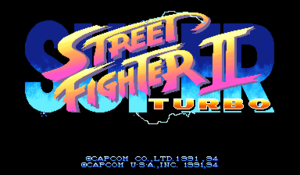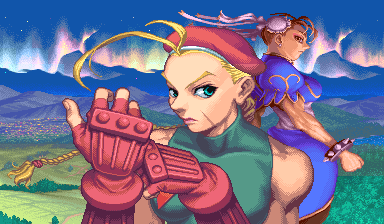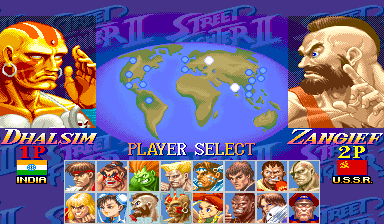ReckyDaGuy (talk | contribs) (Edited the infobox with more accurate information and edited the introduction paragraph to flow better.) |
ReckyDaGuy (talk | contribs) (→Introduction: trimmed the fat from the Introduction and reduced it to only what's relevant in Super Turbo) |
||
| Line 31: | Line 31: | ||
Super Street Fighter II Turbo, or Super Street Fighter II X: Grand Master Challenge in Japan, is the fifth revision of Street Fighter II. This version builds upon the foundations set by the previous versions (Street Fighter II: The World Warrior, Street Fighter II': Champion Edition, Street Fighter II': Hyper Fighting ("Turbo" in Japan), and Super Street Fighter II: The New Challengers) with balance changes, new moves, and new features to polish an already revolutionary title into a game that stands the test of time. | Super Street Fighter II Turbo, or Super Street Fighter II X: Grand Master Challenge in Japan, is the fifth revision of Street Fighter II. This version builds upon the foundations set by the previous versions (Street Fighter II: The World Warrior, Street Fighter II': Champion Edition, Street Fighter II': Hyper Fighting ("Turbo" in Japan), and Super Street Fighter II: The New Challengers) with balance changes, new moves, and new features to polish an already revolutionary title into a game that stands the test of time. | ||
Super Turbo's defining new addition is Super Combos. By using special moves, you can fill your character's Super Combo gauge on the bottom of the screen, and when it's full, you can unleash your character's most powerful move, potentially turning the tide of the entire match. Also notable was the return of Turbo speed, introduced in Hyper Fighting and removed in Super. You could also adjust the speed yourself to multiple settings, depending on the arcade operator's configuration. For those skilled enough to complete the arcade mode on 1 credit, a new secret final boss awaits. Akuma/Gouki is notable for his extreme power, to the point where even his toned-down playable form selectable via a secret code is banned in tournament play. | |||
Old favorites received new tools in their kit with new moves, such as Chun-Li's Tenshokyaku anti air kicks, Zangief's Banishing Flat green hand of projectile destruction, and E.Honda's massively powerful Oicho Throw. Every character also gained access to the ability to soften throws. In previous versions, you had no way whatsoever to defend against throws outside of reversals, but now if you input the throw command right after your opponent throws you, you'll take less damage and recover quicker. Finally, every character besides Akuma has access to a version of themselves similar to their iterations from Super Street Fighter II: The New Challengers, often called Old Characters or Super Characters. Selectable via a code, these versions didn't have access to Super Turbo's new mechanics such as Super Combos, throw softening, or any new moves added in this version, but while most of them have been disregarded as worse versions of their New counterparts, some Old characters are as good as or even better than their New counterparts in competitive play. | |||
Despite many decades passing and a deluge of new fighting games to play, Super Street Fighter II Turbo has been played competitively since its release and has been featured in countless major fighting game tournaments, such as the Evolution Championship Series/EVO and SBO/Tougeki. To this day, it is a beloved old-school game and still recognized by many professional-level players as one of the best fighting games of all time. | Despite many decades passing and a deluge of new fighting games to play, Super Street Fighter II Turbo has been played competitively since its release and has been featured in countless major fighting game tournaments, such as the Evolution Championship Series/EVO and SBO/Tougeki. To this day, it is a beloved old-school game and still recognized by many professional-level players as one of the best fighting games of all time. | ||
Revision as of 00:10, 12 November 2022
| Super Street Fighter II Turbo (ST, SSFIIT, SSFIIX) | |
|---|---|
| Developers |
Capcom |
| Systems |
CPS-II (Arcade) |
| 3DO NA: November 7, 1994 JP: November 14, 1994 AU: November 21, 1994 EU: November 23, 1994 | |
| PC-DOS NA: May 5, 1995 AU: June 1, 1995 EU: June 2, 1995 | |
| Amiga EU: 1995 | |
| Sega Saturn (Street Fighter Collection) JP: September 18, 1997 NA: November 30, 1997 EU: 1997 | |
| PS1/PSX (Street Fighter Collection) JP: October 23, 1997 NA: November 30, 1997 EU: July, 1998 | |
| Dreamcast (For Matching Service) JP: December 22, 2000 | |
| Game Boy Advance (Turbo Revival) JP: July 13, 2001 NA: October 30, 2001 AU: November 1, 2001 EU: November 2, 2001 | |
| PS2 (Capcom Classics Collection Volume 2) NA: November 24, 2006 EU: April 13, 2007 AU: April 11, 2007 | |
| Online Play |
FightCade (PC, rollback) |
Introduction
To many, this game needs no introduction.
Super Street Fighter II Turbo, or Super Street Fighter II X: Grand Master Challenge in Japan, is the fifth revision of Street Fighter II. This version builds upon the foundations set by the previous versions (Street Fighter II: The World Warrior, Street Fighter II': Champion Edition, Street Fighter II': Hyper Fighting ("Turbo" in Japan), and Super Street Fighter II: The New Challengers) with balance changes, new moves, and new features to polish an already revolutionary title into a game that stands the test of time.
Super Turbo's defining new addition is Super Combos. By using special moves, you can fill your character's Super Combo gauge on the bottom of the screen, and when it's full, you can unleash your character's most powerful move, potentially turning the tide of the entire match. Also notable was the return of Turbo speed, introduced in Hyper Fighting and removed in Super. You could also adjust the speed yourself to multiple settings, depending on the arcade operator's configuration. For those skilled enough to complete the arcade mode on 1 credit, a new secret final boss awaits. Akuma/Gouki is notable for his extreme power, to the point where even his toned-down playable form selectable via a secret code is banned in tournament play.
Old favorites received new tools in their kit with new moves, such as Chun-Li's Tenshokyaku anti air kicks, Zangief's Banishing Flat green hand of projectile destruction, and E.Honda's massively powerful Oicho Throw. Every character also gained access to the ability to soften throws. In previous versions, you had no way whatsoever to defend against throws outside of reversals, but now if you input the throw command right after your opponent throws you, you'll take less damage and recover quicker. Finally, every character besides Akuma has access to a version of themselves similar to their iterations from Super Street Fighter II: The New Challengers, often called Old Characters or Super Characters. Selectable via a code, these versions didn't have access to Super Turbo's new mechanics such as Super Combos, throw softening, or any new moves added in this version, but while most of them have been disregarded as worse versions of their New counterparts, some Old characters are as good as or even better than their New counterparts in competitive play.
Despite many decades passing and a deluge of new fighting games to play, Super Street Fighter II Turbo has been played competitively since its release and has been featured in countless major fighting game tournaments, such as the Evolution Championship Series/EVO and SBO/Tougeki. To this day, it is a beloved old-school game and still recognized by many professional-level players as one of the best fighting games of all time.
<style>.st-screen { height: auto; aspect-ratio: 4/3 }</style>



































